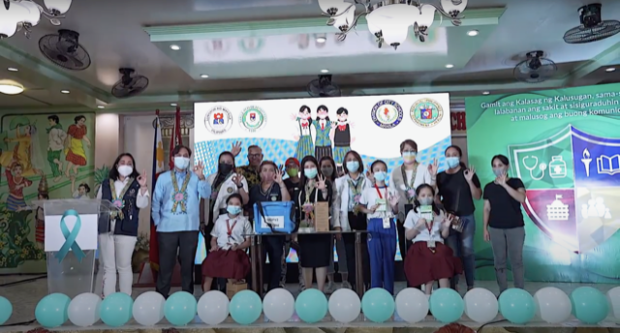City of Manila leads school-based HPV immunization program of female learners
In a multistakeholder collaboration, the Department of Health (DOH), the Department of Education (DepEd) and the Local Government of City of Manila, in partnership with healthcare company MSD in the Philippines, organized a school-based vaccination event titled “Sa Aking Paglaki, Walang HPV” at Aurora Quezon Elementary School.
The event was organized pursuant to DepEd Memorandum No. 173, series of 2017, also known as the “Inclusion of the Human Papilloma Virus (HPV) Vaccination in School-Based Immunization Program,” as well as DOH Department Memorandum No. 2015-0316, also known as “Guidelines in the Implementation of HPV Vaccination.”

The School-based Immunization Program (SBIP) aims to protect school-aged children against vaccine-preventable diseases. In 2015, the DOH introduced the HPV vaccination program in public schools nationwide. It has since expanded to benefit female Grade 4 students aged 9 to 13 years old to help protect them against cervical cancer. This age group benefits the most from the vaccination program as they are not yet exposed to HPV, which usually results from sexual activity.
One hundred fifty (150) female learners from Aurora Quezon Elementary School have received the HPV vaccination during the activity.
Prior to administering the vaccine, parents’ consent must first be obtained by school officials. That is why vaccination education campaigns usually highlight the role of parents in fortifying the health shield of their children through timely vaccination against diseases.
Burden of cervical cancer
Cervical cancer is largely preventable through both vaccination and screening for precursor lesions, with appropriate follow up and treatment. It typically develops over several years, providing ample time to detect and treat abnormal changes in cervical cells that could eventually lead to cancer. With access to information, preventive services, and routine gynecological care, most cases of the disease can be prevented and successfully treated at an early stage.
In spite of this, cervical cancer ranks as the 2nd most frequent cancer among women in Philippines and the 2nd most frequent cancer among women between 15 and 44 years of age. Current estimates indicate that every year 7,897 women are diagnosed with cervical cancer and 4,052 die from the disease.
Cervical cancer develops at the entrance to the uterus from the vagina and around 99 percent of the cases are linked to HPV or human papillomaviruses. Modes of transmission include sexual contact, skin-to-skin contact and rarely, through objects exposed to the virus.
Things you need to know about HPV
One life-altering issue that deserves focus is the huge burden that continues to threaten women and men, including teenagers worldwide, caused by the human papillomavirus or HPV. HPV is a common virus that is passed from one person to another during sexual contact.
Although some of the infections from this commonly occurring virus with more than 100 types usually go away on their own, at least 14 types of HPV have been found to be cancer-causing.
These HPV-related cancers and diseases are cervical cancer, vaginal and vulvar cancers, penile cancer, anal cancer, oropharyngeal cancer, and genital warts.
The Philippines has a population of 37.8 million women ages 15 years and older who are at risk of developing cervical cancer. About 2.9% of women in the general population are estimated to harbor cervical HPV-16/18 infection at a given time, and 58.6% of invasive cervical cancers are attributed to HPVs 16 or 18. While most infections will go away on their own, those that don’t go away can cause certain types of cancer including:
- Cervix, vagina, and vulva in women
- Penis in men
- Anus in both men and women
- Back of the throat (called oropharyngeal cancer), including the base of the tongue and tonsils, in both men and women
HPV vaccines can be given starting at nine years old to both girls and boys. It is recommended that all preteens have HPV vaccination, so they are protected from HPV infections that can cause cancer later in life. Teens and young adults through age 26 years who didn’t start or finish the HPV vaccine series also should have HPV vaccination. Women up to age 45 may be eligible for vaccination after discussing with their provider.
Towards a cervical cancer-free future
The elimination of cervical cancer has been defined as achieving an incidence rate low enough for the disease to be considered controlled as a public-health problem; this threshold has been defined by the WHO as fewer than 4 cases per 100,000 women per year.

To accomplish this, every country must reach and maintain three key targets, within the lifetime of today’s young generation. The first is for 90 per cent of girls to be fully vaccinated against the human papillomavirus (HPV) by the age of 15. The second is to ensure that 70 per cent of women are screened using a high-performance test by the age of 35, and again by age 45. The final target is for 90 per cent of women with pre-cancer to receive treatment and for 90 per cent of women with invasive cancer to have their condition properly managed.
Achieving this vision and each of the elimination targets will require a whole-of-society and multisectoral approach to ensure health systems prioritize women and girls. Individuals, families, communities, , civil society, and government agencies at all levels have a role to play in championing greater awareness, education, and social support.
Together, let’s commit to women everywhere to end cervical cancer.
ADVT.














